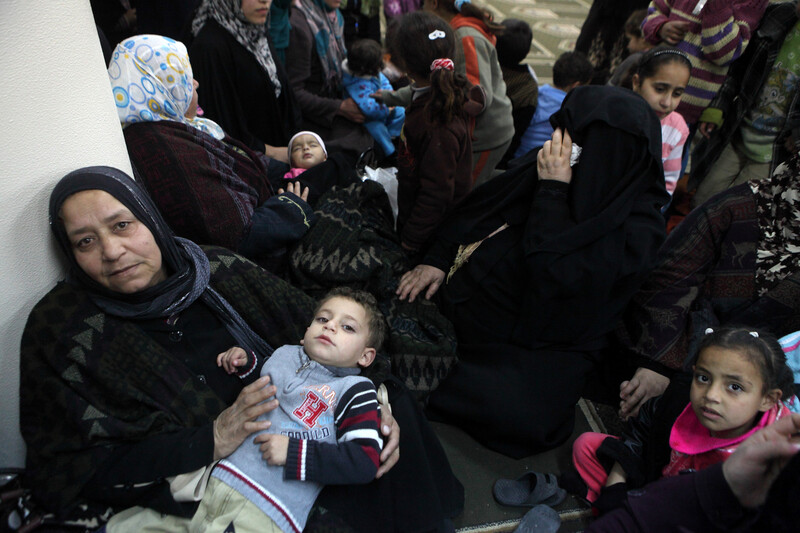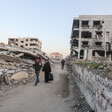The Electronic Intifada Gaza City 13 February 2012

Umm Khaled al-Najjar, holding her grandson, takes shelter at a mosque after Gaza authorities destroyed her family’s home.
ActiveStills“Many of us women and children have gathered here at this mosque, after bulldozers demolished our homes. Unfortunately, those who displaced us are not the Israelis this time, but our own brothers in Gaza,” said an angry Umm Khaled al-Najjar, 50, as she held her grandson.
Al-Najjar and dozens of other women and children from the Hamami coastal neighborhood in western Gaza City took shelter last Wednesday at the mosque on the al-Rashid road after the demolitions of their homes on the orders of the Gaza municipality and the Gaza Lands Authority.
“They attacked our neighborhood early on Wednesday morning,” al-Najjar told The Electronic Intifada. “A contingent of police including female officers stormed the home and I fainted after the police hit my son in his back. Believe me, what happened is similar to Israeli actions against us for the past four decades, it is unbelievable, unbelievable.” The interview took place on Wednesday afternoon, as bulldozers were still flattening the area.
Abdullah Miqdad is another area resident. An elderly man, he was sitting on the road with many other men from the same demolished neighborhood. Anger, sadness and depression were drawn on the face of Miqdad and his neighbors, as the loud roar of the bulldozers could be heard in the background.
“I am the head of an eight member family and I recall that my father and I, when I was a child, were forced out of the Palestinian town of Hamama back in 1948, when Israeli occupation forces expelled us all from Palestine,” Miqdad said. “I wonder why they have done this excessive thing to us.”
Adel Abu Shiail owned a small grocery shop and house in the area. Both were victims of the bulldozers. “What happened to us has let our tears flow,” Abu Shiail said. “Yes, I cried, for this was my home for many years. I cried for the shop that was my main source of income for me and my five daughters. Where should we go, what should we do now?”
Abu Shiail said that he used to work in Israel, but that became impossible after 2000 due to tightened closures and the store had been his main sustenance.
Local fisherman and resident Ahmad Abu Samaan expressed the shock that many of his neighbors felt: “We never expected that these people, who must be our national authority, would even dare to attack us so brutally and force us out of our homes in which we lived for decades. Why did they do it? Why?”
Official explanations

Gaza authorities say the demolitions are necessary to implement a major traffic improvement project.
ActiveStillsAt the Gaza municipality building in Gaza City, those responsible for the demolitions were more than happy to provide their own explanation of what was going on.
“We in the municipality have rarely executed such major projects in the coastal city. This is due to the fact that the Israeli blockade of Gaza as well as the frequent Israeli army attacks on the region prevented us doing so,” Hatem al-Sheikh Khaleil, an engineer, said, “This is the first time that we embark on such a large-scale bulldozing as we are going to start a major infrastructure project.”
Khaleil said the project — to widen the 40 kilometer al-Rashid coastal road and install a sewage and water network in the coastal area of western Gaza City — was in cooperation with the Gaza-based Lands Authority and the Palestine Telecommunication Company, under a German grant of €11 million ($14.5 million).
The al-Rashid coastal road is one of two main roads in the Gaza Strip and much of the traffic here relies on it, especially in summer time. The road is too narrow to absorb the traffic of 1.6 million residents of the tiny coastal territory, according to municipal officials in Gaza.
“For the past six months we have been trying to kick off this vital infrastructure project. It is true that Gaza needs a lot of repair from the great damage that the region has suffered due to the Israeli blockade and attacks. So it is also imperative that we start such an internationally-funded project,” Khaleil added.
Over the past five years, the Gaza authorities have been unable to commence reconstruction projects across the coastal enclave due to continued lack of raw materials, caused by the Israeli blockade of Gaza. This is the first time since the blockade that Palestinians in Gaza are able to execute major infrastructure projects.
Compensation
The Palestinian Lands Authority in Gaza told the Electronic Intifada that the fifty displaced families will be transferred to government-owned lands in southern Gaza Strip city of Khan Younis.
“For the past six months, the Lands Authority sent out several notices to these families to vacate their homes ahead of demolitions,” Amal Shamali, a spokesperson for the Lands Authority said.
“We negotiated with representatives of the families over a land swap in the northern Gaza Strip and near the beach also. The chief of the Lands Authority himself went along with representatives of the families to the Attatra area, but later they refused our offer,” she added.
According to the Lands Authority, the targeted Hamami neighborhood has always been government-owned land and therefore, from an official point of view, the residents were squatters.
“On 17 January, the Hamas-led cabinet in Gaza approved compensation to the residents of the Hamami neighborhood, on which the expansion of the road and the sewage water network will be implemented. The government allocated urgent assistance of $1,500 for each displaced family to rent a home for six months. Also, under the land swap, each family will get a piece of land from 150 square meters to 300 square meters at a discounted price, to be paid by monthly installments for a period of ten years,” Shamali said.
Yet such arrangements were not on the minds of the shocked residents of the now demolished neighborhood.
“At least they should have notified us about the demolitions a few days ago, not come overnight abruptly and start bulldozing our homes. This is so cruel by a government that is supposed to be our own Palestinian national government,” said Adel Abu Shiail, angrily pointing his finger at a bulldozer that had just demolished his store.
The displaced families now face an uncertain future, far from the homes in which many have lived for 63 years.
Rami Almeghari is a journalist and university lecturer based in the Gaza Strip.





